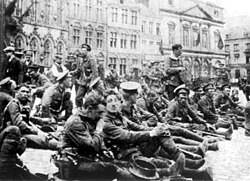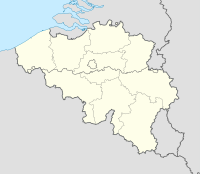| Battle of Mons | |||||||||
|---|---|---|---|---|---|---|---|---|---|
| Part of the Battle of the Frontiers of the First World War | |||||||||
 British soldiers from the Royal Fusiliers resting in the town square at Mons before entering the line prior to the Battle of Mons. The Royal Fusiliers faced some of the heaviest fighting in the battle and earned the first Victoria Cross of the war. | |||||||||
| |||||||||
| Belligerents | |||||||||
|
|
| ||||||||
| Commanders and leaders | |||||||||
|
| |||||||||
| Strength | |||||||||
|
| ||||||||
| Casualties and losses | |||||||||
| 1,638 | 2,000–5,000 | ||||||||
Mons: Belgian town and capital of Hainaut | |||||||||
The Battle of Mons was the first major action of the British Expeditionary Force (BEF) in the First World War. It was a subsidiary action of the Battle of the Frontiers, in which the Allies clashed with Germany on the French borders. At Mons, the British Army attempted to hold the line of the Mons–Condé Canal against the advancing German 1st Army. Although the British fought well and inflicted disproportionate casualties on the numerically superior Germans, they were eventually forced to retreat due both to the greater strength of the Germans and the sudden retreat of the French Fifth Army, which exposed the British right flank. Though initially planned as a simple tactical withdrawal and executed in good order, the British retreat from Mons lasted for two weeks and took the BEF to the outskirts of Paris before it counter-attacked in concert with the French, at the Battle of the Marne.
